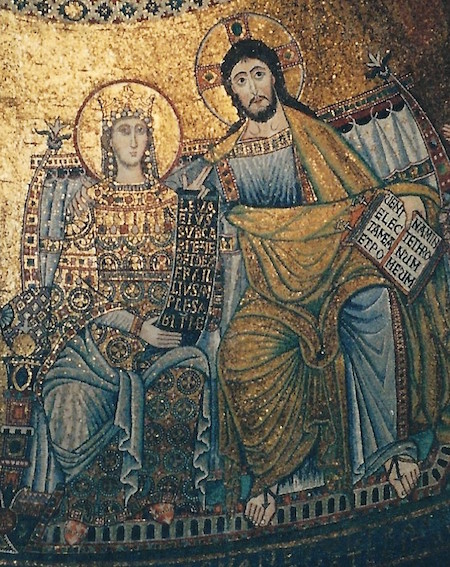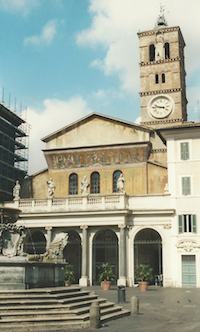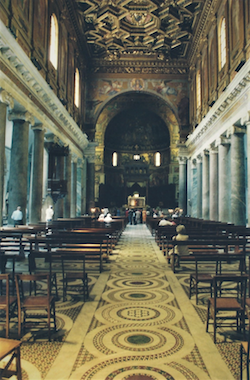
.
ChristoSophia in Trastavere

It was Pentecost Sunday in Rome – June 3, 2001. We opened the massive wooden doors of Casa di Santa Francesca Romana, the monastery where we were staying, and stepped into th e narrow streets of Trastavere. The monastery which was once the home of Santa Francesca Romana, a female saint of the early 15th century who ministered to the poor of Trastavere, now provides lodging for pilgrims such as ourselves who are seeking a more authentic experience of Rome than the tourist hotel can provide. The neighborhood of Trastavere, located across the Tiber River from the ruins of old Rome, is still the same working class neighborhood and home to many immigrants as it was in St. Francesca’s time.
e narrow streets of Trastavere. The monastery which was once the home of Santa Francesca Romana, a female saint of the early 15th century who ministered to the poor of Trastavere, now provides lodging for pilgrims such as ourselves who are seeking a more authentic experience of Rome than the tourist hotel can provide. The neighborhood of Trastavere, located across the Tiber River from the ruins of old Rome, is still the same working class neighborhood and home to many immigrants as it was in St. Francesca’s time.
This Sunday morning was especially beautiful, with the azure blue sky and cool breeze of early summer. We walked along the winding streets, fla nked by the ochre colored buildings covered in ivy that housed both shops and living quarters. The streets were noisy this morning, with families headed to church and people enjoying their holiday in the crowded cafes. The smells of roasting chicken and pungent herbs wafted through an upstairs window where we envisioned grandma cooking Sunday dinner, the smells mingling with the sharp odors of the street. Savoring this rich sensory experience which we had found to be the essence of Rome, we walked the few blocks to our destination, the church of Santa Maria in Trastavere.
nked by the ochre colored buildings covered in ivy that housed both shops and living quarters. The streets were noisy this morning, with families headed to church and people enjoying their holiday in the crowded cafes. The smells of roasting chicken and pungent herbs wafted through an upstairs window where we envisioned grandma cooking Sunday dinner, the smells mingling with the sharp odors of the street. Savoring this rich sensory experience which we had found to be the essence of Rome, we walked the few blocks to our destination, the church of Santa Maria in Trastavere.
We had selected this church for our worship on this Pentecost Sunday because of its contemporary as well as its historical significance. Not only is it the central basilica for the people of Trastavere today, but it is also thought to be the oldest site of Christian public worship in Rome. The church was founded by Pope Callixtus in the third century, during the pagan era of Christian persecution. The story of a miracle also accompanies its origins. According to legend, a fountain of oil suddenly appeared on this site as a prophetic sign of Christ’s birth.
Having read about the history of Santa Maria, we felt that we had been led to this spot in Trastavere where this small, but immensely significant, church was the focal point. And, in our search for the feminine in Christianity, we felt especially blessed to discover the church of Santa Maria – dedicated to the Madonna – which many historians believe was the first church in the world to be dedicated to the Virgin Mary.
 As we entered the ancient square with its central fountain, we caught our first glimpse of the church of Santa Maria. We saw a Romanesque basilica with its traditional campanile, a 12th century structure that replaced a building of the 3rd century. In my initial view of Santa Maria, I was immediately struck by the medieval mosaic frieze on the façade which displayed the Virgin Mary surrounded by a procession of female figures bearing oil lamps. I was very moved by her appearance, which bore a strong resemblance to the image of the ancient goddess surrounded by her priestesses.
As we entered the ancient square with its central fountain, we caught our first glimpse of the church of Santa Maria. We saw a Romanesque basilica with its traditional campanile, a 12th century structure that replaced a building of the 3rd century. In my initial view of Santa Maria, I was immediately struck by the medieval mosaic frieze on the façade which displayed the Virgin Mary surrounded by a procession of female figures bearing oil lamps. I was very moved by her appearance, which bore a strong resemblance to the image of the ancient goddess surrounded by her priestesses.
But as I stepped inside the door of Santa Maria, the strong emotions I was experiencing deepened to amazement and awe as I gazed upward at the central mosaic in the half domed apse of the church. For there was Mary – the Queen of Heaven – seated beside Christ, sharing the same throne. The golden mosaic tesserae which made up her celestial crown and robes glittered like heavenly jewels as the sunlight of the bright morning poured through the side windows and illumined her image.
Her eyes, expressing the wisdom of the cosmos, gazed serenely ahead – seemingly looking right at me, seeing through me. She was truly the transcendent, supernal feminine power of the universe.
I was awed by the luminous, living beauty of the image of Mary, but even more amazed at this expression of the “Coronation of the Virgin” motif which appears frequently in 12th century Christian art. In the usual depiction of the “Coronation,” which expresses the transcendent nature of the Virgin Mary as she appears in Heaven, Christ is shown as bestowing the crown upon her. This implies that even in Heaven Mary is dependent upon Christ – the feminine is subservient to the masculine. This of course has been the formal teaching of the Christian church throughout the ages. But here, in the earliest Christian church in Rome, the medieval artists who so skillfully rendered this glorious mosaic chose instead to depict the Virgin Mary and Christ as reigning together, as equal, in Heaven. Especially significant to me was the realization that this vision of equality was the first example of the “Glorification of the Virgin” motif in Christian art. The beauty of the image and the message brought tears to my eyes.

For here before me was the most authentic and numinous symbolic expression I had ever seen of ChristoSophia. The transcendent Queen of Heaven depicted in the mosaic reveals the Virgin Mary as Sophia, the feminine power that permeates the cosmos, just as it shows the resurrected Lord Jesus as Christ, the masculine power that rules over all creation. The artistic depiction of their joint reign in Heaven expresses the spiritual truth of ChristoSophia – a unity which, in our world of polarities, is differentiated as masculine and feminine aspects of God. The Christ and Sophia powers have expressed themselves through the God and Goddess images of all cultures; the spiritual impulse is the same, although the expression varies. In the Christian religion these powers have manifested through the persons of Jesus and Mary. However, we must always remember that the spiritual powers – Christ and Sophia – transcend their human manifestations. In Christianity, when the Divine Feminine is recognized at all, it is usually seen
in the Virgin Mary as the mother of Jesus. This truncates the power of the archetypal feminine, Sophia, and separates her from the Christ. In ancient cultures, the Divine Feminine was seen as the mother and the consort of the God – as mother, the Source of Life; as consort, the female aspect of the divine Unity. This ancient spiritual truth, although never officially acknowledged by the Christian Church, nevertheless continued to be subtly conveyed through artistic images of the Coronation of the Virgin, where both Christ and Mary (Sophia) reign together in Heaven. The image in the mosaic at Santa Maria in Trastavere affected me so deeply because it so clearly shows the truth of Christ and Sophia sitting equally on the throne of Heaven – reigning as consorts and ruling as full spiritual partners. It is a sublime image of ChristoSophia, the differentiated unity of the Divine.
 We sat for a long time in the church before the service began, contemplating the image of ChristoSophia as the changing sunlight illuminated various aspects of the mosaic in its brilliant shades of gold. The image truly seemed to be alive and full of power. During this time of reflection I meditated further upon the significance of this Pentecost Sunday. On the original day of Pentecost, the Holy Spirit descended upon the disciples as a “rush of wind” and
“tongues of fire.” (Acts 2: 2-3) This marked the descent of the Sophianic Spirit that empowered the disciples and initiated the early Christian community. It is the resurrected Christ as Sophia-Spirit that resides within all human beings and the natural world. As I meditated upon the apse mosaic, I realized that this is the union symbolized in the image of Christ reigning with Mary in Heaven – the union of Christ and Sophia that underlies the power of the Pentecostal event.
We sat for a long time in the church before the service began, contemplating the image of ChristoSophia as the changing sunlight illuminated various aspects of the mosaic in its brilliant shades of gold. The image truly seemed to be alive and full of power. During this time of reflection I meditated further upon the significance of this Pentecost Sunday. On the original day of Pentecost, the Holy Spirit descended upon the disciples as a “rush of wind” and
“tongues of fire.” (Acts 2: 2-3) This marked the descent of the Sophianic Spirit that empowered the disciples and initiated the early Christian community. It is the resurrected Christ as Sophia-Spirit that resides within all human beings and the natural world. As I meditated upon the apse mosaic, I realized that this is the union symbolized in the image of Christ reigning with Mary in Heaven – the union of Christ and Sophia that underlies the power of the Pentecostal event.

The worship service itself carried on the warm, loving feeling of the feminine imagery. Not only was it a celebration of Pentecost, but also a service of Confirmation. The flowing, melodious Italian of the liturgy was deeply moving as all the Guidos, Guiseppes, Salvatores, Guilias, Cecilias, and Flavias presented themselves to the Archbishop and received the gift of the Holy Spirit. The church was full of the townspeople of Trastavere and, even though “outsiders,” we experienced the true feeling of community that permeated the church. Even though we didn’t understand much of the language, we perceived the emotional and spiritual essence of the worship service, and experienced the re-enactment of Pentecost – the descent of the love and wisdom of ChristoSophia – within all of us who worshipped on this day. It was a very sacred – but also very human – service, and we could feel a real synthesis of the spiritual and earthly, the masculine and feminine. Thus it too was a reflection of the ancient “sacred marriage” that is depicted in the church’s central image of Christ united with Mary (Sophia). This is the “sacred marriage” that unites the opposites of feminine and masculine, material and spiritual, time and eternity within the human heart.
As the service drew to its close, we joined the other worshippers in the recessional, all of us clapping our hands to accompany the organ’s rollicking tune. As the throng poured out of the basilica, we were filled with joy and gratitude. We walked into the sunny piazza where children and dogs were playing around the fountain and the cafes were filled with people enjoying their Sunday dinners. A scene so full of life and beauty – Sunday in Rome – again, a perfect blend of Heaven and Earth. I knew that ChristoSophia was present here in Trastavere.
Back to top
The artistic depiction of their joint reign in Heaven expresses the spiritual truth of ChristoSophia – a unity which, in our world of polarities, is differentiated as masculine and feminine aspects of God.
The church of Santa Maria in Trastavere… many historians believe was the first church in the world to be dedicated to the Virgin Mary.
Her eyes, expressing the wisdom of the cosmos, gazed serenely ahead… She was truly the transcendent, supernal feminine power of the universe.
This version of equality was the first example of the “Glorification of the Virgin” motif in Christian art.
The transcendent Queen of Heaven depicted in the mosaic reveals the Virgin Mary as Sophia, the feminine power that permeates the cosmos.
… in the earliest Christian church in Rome, the medieval artists who so skillfully rendered this glorious mosaic chose to depict the Virgin Mary and Christ as reigning together, as equal, in Heaven.